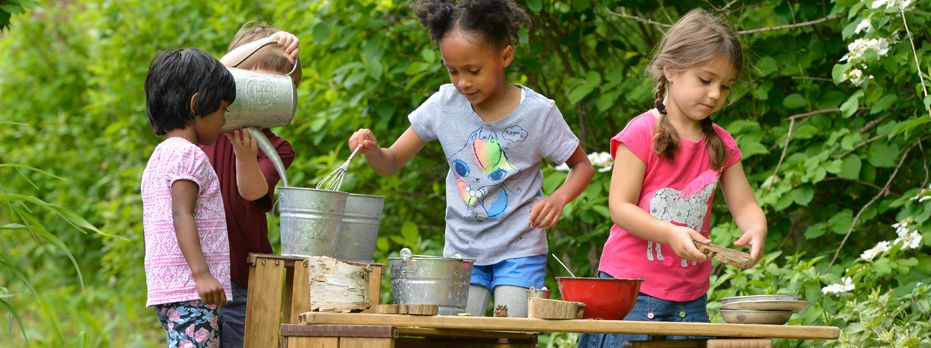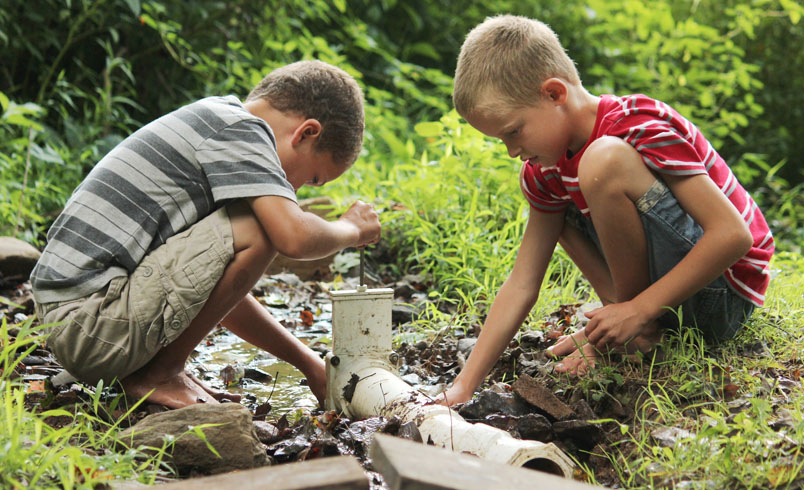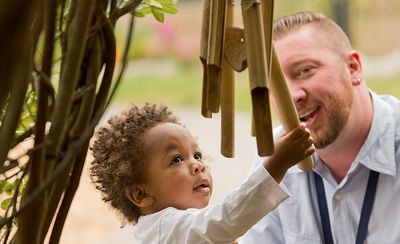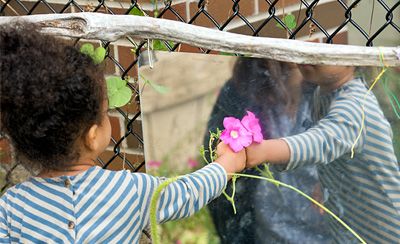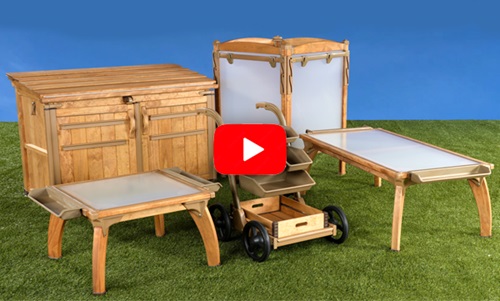Laboratory for Learning:
The Power of Outdoor Classrooms to Fuel Creativity
| March 2017When you think of creativity what comes to mind? For most of us it is the arts: drawing, painting, writing, or dancing. While those are indisputably creative endeavors, creativity is also a way of thinking and learning across all domains. Being creative is about making connections and seeing things from different perspectives. It includes problem-solving, flexible thinking, and strategizing.
As a society, perhaps now more than ever, we need people who can use creativity to solve problems, adapt to a variety of situations, and communicate effectively with others. We need people who are critical thinkers, on the lookout for better ways of doing things and “doers”, ready to express their creativity by trying out ideas.
Our ability to think creatively, as with other skills, grows with nurturing and use. How can we provide opportunities for children to work creatively? Regular time outdoors in nature is one time-tested way to fuel creativity. Nature effectively invites the hands-on, messy play that nourishes children’s creative problem-solving while also providing encounters with real challenges to remedy. Natural outdoor classrooms are creative laboratories for children to learn effectively in ways that are compatible with human evolution and the latest brain research.
Evolutionary science tells us that the brain is designed to solve problems. Brain research shows that the mind operates most effectively when the body is in motion. The brain is not designed to sit still and memorize. According to John Ratey, MD, in his book Spark, the evidence is incontrovertible: aerobic exercise physically remodels our brains for peak performance. “As far as our brains are concerned, if we aren’t moving, there is no real need to learn anything” (Ratey, 2008). So if movement is essential to learning, how do traditional educational environments (indoor classrooms) ideally supporting learning? John Medina, in Brain Rules: 12 Principles for Surviving and Thinking at Home, Work and School, doesn’t think they do. He says, “If you wanted to create an education environment that was directly opposed to what the brain was good at doing, you probably would design something like a classroom.”Conversely, well-designed and nature-filled outdoor classrooms that encourage children’s movement and that are ripe with opportunities for making choices, truly support flexible and creative thinking. Natural outdoor classrooms provide for strong brain development. They are ideal, even magical, places for play and learning. These spaces afford young children many opportunities for investigation, problem-solving, thinking, rethinking, and refining their notions and understanding of how the world works. In Nurturing Creativity, authors Isbell and Yoshizawa describe the role of the educator in arranging the environment this way: “Early childhood teachers have the amazing opportunity to value, support, and design an environment that nurtures young children’s creative abilities, a place where children are able to think, explore, play with ideas, and be courageous in their innovations.” In our study of creativity in the preschool years (Kiewra & Veselack, 2016) we found that children’s creativity and imagination was evident when the following factors were in place: a thoughtfully designed natural outdoor classroom; large blocks of uninterrupted time provided for children; an abundance of natural and open-ended materials consistently available; and the presence of caring, supportive adults.
The adult role outdoors in supporting creativity should not be underestimated. Creativity flourishes when educators understand the value of regular outdoor time for children and their important role in supporting learning in and with nature. Adults make important decisions in-the-moment as they decide when to jump in to assist with challenging tasks, when to join as a play partner, when to encourage children to take the lead, and when being an observer is what is most supportive. Additionally, children benefit when caregivers and educators regularly offer opportunities for revisiting prior experiences and materials. That reflection often leads to new ideas and more complex thinking.
Here are two scenarios from early education programs which illustrate how this rich learning happens. These anecdotes about creating a dinosaur out of sticks and a puzzle out of bark include aspects of learning such as identifying a “problem” or “opportunity”, forming a plan, experimenting, and working towards a goal. Notice how the children are self-guided in their processes and confident in their abilities.
These anecdotes illustrate the joyful, rich, creative learning that is possible for all young children. They show that early education goes beyond the typical academic areas and school walls. Regular experiences in the natural world provide for learning experiences that nurture creativity, flexible thinking, and problem-solving skills that will serve our children beyond school into adulthood. Creative problem-solving drives economic growth and factors into finding solutions to societal challenges. For these reasons, creativity can maximize human potential, people’s sense of well-being, and positive societal change.
The Dinosaur
“Wahoo! I’m so excited I found a saber tooth fossil. Be careful, it’s very fragile.” William, a four-year-old at the Child Educational Center in California, had been exploring the natural materials scattered about the sandbox when he came upon his discovery. He began collecting and piling up more natural materials, calling them fossils. He was narrating his process out loud. “I found the entire remains of a stegosaurus, so many fossils. Now I have to put it together.” He began to construct the stegosaurus and said, “The stegosaurus’ brain is the size of a walnut.” He held up a small piece and said, “This is the tiniest piece ever! It’s the brain.” He continued to move around putting together the skeleton. “It’s finished! Come and see. I’m the discoverer.” He then started to add more pieces to the stegosaurus and said, “It can switch into a jet. It’s a switch and go dino!” William worked on this for over an hour in the early morning when the yard was fairly empty of children, but full of possibilities. His creativity and problem-solving is very evident as he selected materials, built his stegosaurus and then transformed it into a jet.
A Bark Puzzle
Five-year-old Mara, a preschooler at Dimensions Education Programs in Nebraska, found a piece of bark on the ground in the Messy Materials Area of her natural outdoor classroom. She went to the greenhouse to get a magnifying glass to look closely at it. Mara then carefully looked around and gathered more similar looking pieces of bark from the ground nearby. Conscious self-control was involved as Mara worked with the intricate pieces, figuring out where each belonged and how they fit together. First, Mara pieced the bark together on the ground then called her teacher over saying, “Look, see these? It’s just like a big puzzle!” She used her close observation and visual discrimination to feed her working memory as she studied the bark on the ground. Focused and determined, Mara finally decided to fit the pieces back onto the log. The rain the night before left the bark and the log damp enough that they stuck together. This whole experience was her idea, her process, and her accomplishment. Mara was self-guided and confident as she worked.
Ruth Wilson reminds us in her book, Learning is in Bloom that, “Young children are curious, inquisitive, imaginative, and eager to learn. Nature is their world, their natural habitat, a place where they can grow in holistic and authentic ways.” Wilson encourages us to remember that we don’t have to choose between education or enchantment for the young ones in our care because nature has what is needed to accomplish both.
Creativity abounds when young children are in familiar natural habitats, securely attached to their space and the flora and fauna they share it with. Children are filled with the confidence they develop in their predictably organized natural outdoor classroom that is full of intriguing open-ended materials enhanced by the backdrop of natural phenomena like weather and seasonal changes. This sets the stage for exploration, in-depth investigation, and cultivation of a growth mindset for lifelong learning and creativity.
References:
Isbell, R. & S.A. Yoshizawa. 2016. Nurturing Creativity: An Essential Mindset for Young Children’s Learning. Washington, DC: NAEYC
Kiewra, C. & E. Veselack. 2016 “Playing with Nature: Supporting Preschoolers’ Creativity in Natural Outdoor Classrooms”. The International Journal of Early Childhood Environmental Education, 4(1): 70-95
Medina, J. 2008. Brain Rules: 12 Principles for Surviving and Thriving at Work, Home, and School. Seattle, WA: Pear Press
Ratey, J. 2008. Spark: The Revolutionary New Science of Exercise and the Brain. NY, NY: Little Brown
Wilson, R. A. 2016 Learning is in Bloom: Cultivating Outdoor Exploration. Lewisville, NC: Gryphon House, Inc.

